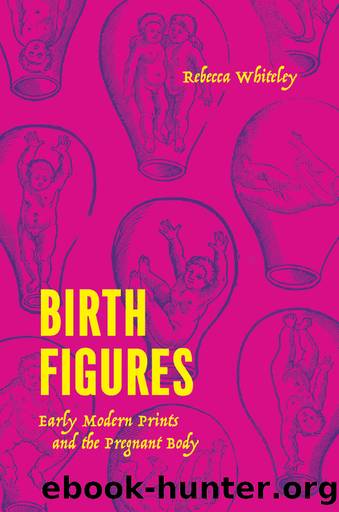Birth Figures by Rebecca Whiteley

Author:Rebecca Whiteley [Whiteley, Rebecca]
Language: eng
Format: epub
Tags: SCI000000 SCIENCE / General, SCI034000 SCIENCE / History, MED005000 MEDICAL / Anatomy, ART050010 ART / Subjects & Themes / Human Figure
Publisher: University of Chicago Press
Published: 2023-02-23T00:00:00+00:00
The Valorized Hand
In the birth figures of the early midwife-authors, it was not just images of the touched body that served to characterize the midwife, but also images of the touching hand. The hand had always been, to some extent, the symbol of the midwife. From the earliest midwifery manuals, we find descriptions of the ideal midwifeâs handâJacques Guillemeau, for instance, requiring âlittle hands & not thicke: cleane, and her nailes pared very neere, and even; neither must shee weare rings uppon her fingers, nor bracelets upon her armes, when shee is about her business.â53 When Guillemeau was writing, in the early seventeenth century, this ideal hand was female. As male authors began to present themselves as public servants and appropriate practitioners, they adopted this feminine ideal, adapting it to incorporate both physically and intellectually masculine attributes. Deventer, for instance, asserted that ânothing ever is more agreeable to the Art of Midwifery, than slender Hands, long Fingers and quick feeling.â54 Slender fingers and âquick feeling,â which implies both physical sensitivity and a mental quickness, are here intertwined. Indeed, more broadly in early modern culture, the hand stood for the low and the high in humans: base sense and manual labor, but also the controlling intellect.55 As Elizabeth Harvey has argued: âtactility, the fundamental sense, the sense contiguous with and essential to all animal life, which is especially pronounced in the vulnerable skin of human nakedness, is paradoxically differentiated from other animals through the concentration of touch in the apprehending and discerning hand. The hand stands for dominion not only over the other animals, but also over the potential for animality within human beings.â56 This understanding dated back to antiquity, to the writings of both Aristotle and Galen, who saw the hand as âthe physical counterpart of the human psyche,â suited not just to particular tasks, but versatile, able to employ various tools and to address âan unrestricted range of subjects.â57 And, of course, according to Galen and many in the seventeenth century who read and followed him, the hand in its special capacities was also the ideal exemplum of Godâs creative dominion.58 It was this association of the hand with the superiority of humans over animals, this connection between physical abilities and intellectual agency, sanctioned by Godâs design, that the new midwife-authors brought to the older physical ideal of slimness.
The operative hands in the birth figures of Mauriceau, Viardel, Siegemund, and Deventer exemplify the complexity of this rhetoric, and particularly the difficulties of reconciling masculine and feminine ideal attributes. Though the rhetoric itself was deeply concerned with gender, it was employed in very similar ways by both men and women. Male authors tended to assimilate traditionally feminine qualities such as small, delicate fingers and soft skin with masculine strength and rationality. Female authors did much the same in reverse, claiming the traditionally masculine attributes of strength and intellectual capability for themselves.
In the birth figures of this period, therefore, we find a unique and curiously androgynous representation of the operative hand.
Download
This site does not store any files on its server. We only index and link to content provided by other sites. Please contact the content providers to delete copyright contents if any and email us, we'll remove relevant links or contents immediately.
| Erotica | Human Figure |
| Landscapes & Seascapes | Plants & Animals |
| Portraits | Religious |
| Science Fiction & Fantasy | Women in Art |
The Art of Boudoir Photography: How to Create Stunning Photographs of Women by Christa Meola(18540)
Red Sparrow by Jason Matthews(5391)
Harry Potter 02 & The Chamber Of Secrets (Illustrated) by J.K. Rowling(3624)
In a Sunburned Country by Bill Bryson(3486)
Drawing Cutting Edge Anatomy by Christopher Hart(3454)
Figure Drawing for Artists by Steve Huston(3384)
Harry Potter and the Prisoner of Azkaban (Book 3) by J. K. Rowling(3304)
The Daily Stoic by Holiday Ryan & Hanselman Stephen(3235)
Japanese Design by Patricia J. Graham(3112)
The Roots of Romanticism (Second Edition) by Berlin Isaiah Hardy Henry Gray John(2878)
Make Comics Like the Pros by Greg Pak(2854)
Stacked Decks by The Rotenberg Collection(2812)
Draw-A-Saurus by James Silvani(2656)
Harry Potter and the Deathly Hallows (7) by J.K. Rowling(2646)
Tattoo Art by Doralba Picerno(2600)
On Photography by Susan Sontag(2577)
Churchill by Paul Johnson(2506)
The Daily Stoic by Ryan Holiday & Stephen Hanselman(2461)
Drawing and Painting Birds by Tim Wootton(2438)
